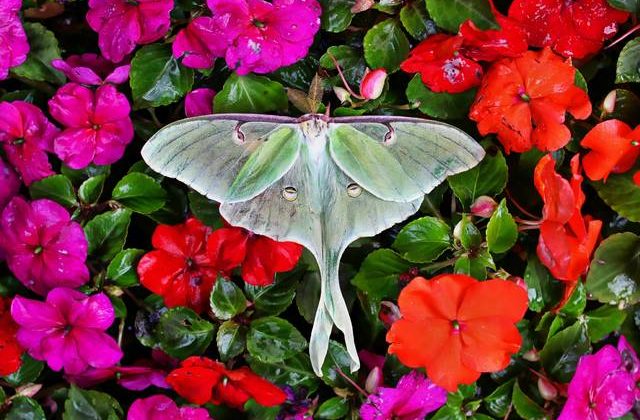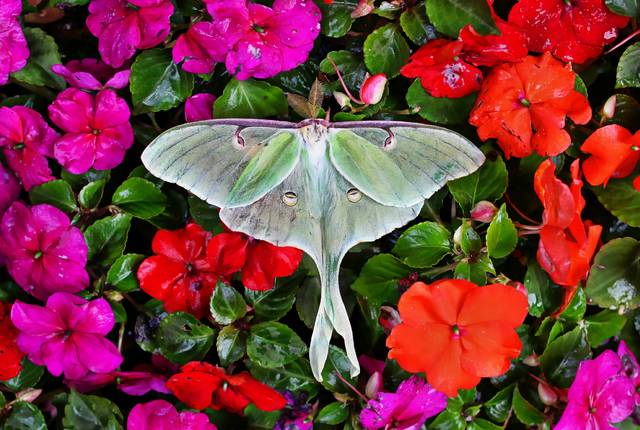
Story by Jane Beathard
Photos courtesy of Tim Daniel, ODNR

Moths are one of the most underappreciated creatures in Ohio gardens, according to naturalist and author Jim McCormac.
“They underpin food webs due to their sheer numbers and by providing a great source of protein,” McCormac said.
Spiders, frogs, toads, lizards, shrews and bats, as well as other insects eat them. But most importantly, they are dinner fare for songbirds.
“Without moths, all songbird species would decline markedly or possibly disappear altogether,” McCormac noted.
Like bees, moths are also pollinators, fluttering from bloom to bloom carrying pollen dust to help plants make seed and reproduce.
There are at least 2,000 species of moths in Ohio alone and another 140 species of butterflies — and, yes, all butterflies are moths.
Dave Horn, professor emeritus of entomology at The Ohio State University, says new species of moths are still being discovered.
Most of Horn’s “moth-ing” took place in the mature forests of southeast Ohio — specifically Vinton, Hocking and Lawrence counties.
“We found over a thousand species in most of those research sites,” he said.
He’s also tallied moths in at least four other states and estimates that he’s seen about 3,000 species altogether.
Fourteen species of moths are endangered in Ohio. Others are threatened or are of special concern. Generally, their numbers are diminished because they are “specialists” that live only on certain plants. Often those plants are only found in prairie habitats and Ohio has few prairies left.
Horn says that fact alone should be major rationale for preserving what prairie remnants the state has.
It’s the caterpillar stage of a moth’s life that is so vital to the food web.
Adults emerge from their winter cocoons in spring to mate. A single female moth can then drop more than 1,000 eggs. By summer, those eggs become caterpillars. Their sheer numbers are overwhelming to contemplate.
But only a tiny percentage of moth caterpillars survive to adulthood.
“There’s a 99 percent mortality rate,” McCormac said.
For example, a recent issue of National Geographic said a nest of Carolina chickadee chicks will consume more than 5,000 caterpillars by the time they fledge.
By fall, the number of moth caterpillars that will over-winter in the cocoon or adult stage is much smaller and manageable. And the life cycle begins all over again.
Some moths, like the hummingbird moth, are beautiful and popular with gardeners. Others less so because they are plain and easy to ignore. Some species come out in daytime, while others venture out only at night.
Both Horn and McCormac always encourage gardeners who value moths to plant woody native plants and avoid pesticide use.
“Native is the key,” McCormac said. “Non-natives attract very few moths.”
Examples are white oak trees, sugar maples, eastern red cedars, paw-paws and river birch. Others include arrowwood, milkweed and spicebush.
McCormac encourages anyone interested in planting for moths to consult the Midwest Native Plant Society at midwestnativeplants.org.
“If you plant it, they will come,” he said.
____
Jim McCormac is the co-author of a soon-to-be-published book, tentatively titled “Gardening For Moths In The Midwest.” It will be published by Ohio University Press.
ID, 'source', true); $sourcelink = get_post_meta($post->ID, 'sourcelink', true); $sourcestring = '' . __('SOURCE','gabfire') . ''; if ($sourcelink != '') { echo "
$sourcestring: $source
"; } elseif ($source != '') { echo "$sourcestring: $source
"; } // Display pagination $args = array( 'before' => '' . __('Pages:','gabfire'), 'after' => '
', 'link_before' => '', 'link_after' => '', 'next_or_number' => 'number', 'nextpagelink' => __('Next page', 'gabfire'), 'previouspagelink' => __('Previous page', 'gabfire'), 'pagelink' => '%', 'echo' => 1 ); wp_link_pages($args); // Display edit post link to site admin edit_post_link(__('Edit','gabfire'),'','
'); // Post Widget gab_dynamic_sidebar('PostWidget'); ?>